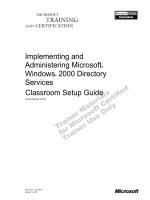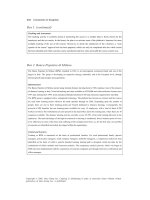Tài liệu Implementing Formal Project Management Processes: 9 Lessons Learned ppt
Bạn đang xem bản rút gọn của tài liệu. Xem và tải ngay bản đầy đủ của tài liệu tại đây (105.29 KB, 6 trang )
Implementing Formal
Project Management
Processes:
9 Lessons Learned
1-800-COURSES
www.globalknowledge.com
Expert Reference Series of White Papers
Introduction
For many years I had the pleasure of working for a Fortune 150 firm with sophisticated, Project Management
Institute (PMI)-based project management (PM) principles. While I am not aware of any formal assessment or
testing done, it was considered a Capability Maturity Model Integration (CMMI) Level 3 organization. After
working in this environment for nine years, I left this job to become an independent, PM consultant.
Having practiced formal PMI-based principles in a supportive cultural environment for many years, I encoun-
tered a few surprises when I began consulting for organizations where no formal PM principles were in place.
Applying structure to once ad-hoc processes can be a challenging,
but rewarding,
venture
. This paper will dis-
cuss the nine lessons learned from my experiences:
1.
Examine the political landscape
2. Identify all stakeholders—friend and foe
3. Anticipate the time it will take to educate stak
eholders
4. Take baby steps
5. Demonstrate the benefits of PM early on with small changes
6. Provide stricter assessment of inputs and estimates
7.
Increase the level of communication
8. Understand the stakeholders’ lack of access to, and understanding of, tools
9.
Understand team members' work focus regarding productive work vs. administrative work
1. Examine the political landscape
As a seasoned project manager
,
I am well aw
are that my projects are only as successful as the upper manage
-
ment support I receive. Because of this, I thought I was ready to assess and react to the support that I would
receive at companies new to me. In meeting with the president of a smaller firm, I had his full support. He was
a believer in project management, having seen the results of some smaller, earlier efforts. With the president’s
full support, I assumed that his staff would follow his direction and support the new efforts as well.
However
,
there w
as one small problem—a senior partner/vice-president.
T
his person was not supportive of any
efforts to change the culture or current business processes. Even though one of the goals of this vice-president
was to offload more of his knowledge to the growing staff, he undermined my efforts to standardize and for-
malize processes, to the point of stopping the project during a status meeting one week. Since I had the
support of the president, I tried to enlist his help. However, while I had his full support one-on-one, the team
w
as not made aw
are of this
.
Also, I learned that the president would step back when dealing with this vice-
president, allowing him to embrace any change
“on his own time”.
Vicki Wrona, Global Knowledge Course Director, PMP
Implementing Formal Project
Management Processes: 9 Lessons Learned
Copyright ©2007 Global Knowledge T
raining LLC All rights reserved.
Page 2
L
esson Learned:
D
on’t underestimate the politics that occur in a small- or medium-sized company. While
politics also exist in large corporations, the interactions in a smaller company are stronger and more like those
of a family--with deeper relationships and barriers. If the politics are too strong, the project may be destined
for failure. Asking more candid questions up front to better ascertain any political obstacles and adequately
address concerns will help. After doing this, professionally and factually express the risk and project viability up
front.
2. Identify all stakeholders – friend and foe
The above is a good example of this lesson, where the vice-president did not support the cultural change to
established methodologies. Another example occurred within a large company, where again I had the full sup-
port of the sponsor. However, I failed to ascertain her other priorities, underestimating the impact that they
would have on the project. Because of that, the sponsor was not available to support the project, and was
unable to resolve important issues, which put several deliverables in jeopardy.
Lesson Learned: Proper, formal stakeholder analysis could have helped avoid, or at least lessen, these issues.
Knowing ahead of time the biases
, priorities, and needs of all stakeholders could have helped me better pre-
pare for these situations.
3. Anticipate the time it will take to educate stakeholders
After working in an organization whose stakeholders understood the basic processes of project management, I
knew I would have to take time to educate my new stakeholders on their roles and responsibilities. However, I
underestimated the time and energy that this would take. Every process, step, document, and sign-off had to
be explained in terms of how it would be done, who was doing it, and most especially, why it would be done.
Without this basic understanding,
team members did not perform adequately
. They were supportive
, but hesi-
tant, unsure of themselves and unaccustomed to the additional requirements put on them.
I expected to explain the processes once
. What caught me by surprise w
as the number of times I had to repeat
and reinforce this information.
This issue w
as coupled with the lack of public support by the sponsor (who
mentioned in Lesson 2). Without this support, team members were supportive of the process as long as it did
not tak
e extra time on their part.
Lesson Learned: Be prepared to clearly and plainly explain your expectations
,
the process
,
and individual
stakeholder roles. Pay extra attention to documenting this information in the project plan and other documents
as necessary. Keep the project documentation as well as any cheat sheets created for them in front of them so
they do not lose focus.
4.Take baby steps
T
he change to using organized project management principles will be new and unfamiliar to stakeholders.
When making changes to an organization’s processes, even an organization that is ISO 9000 certified and
interested in consistent, quality-based processes, the impact of new project management processes can be
large. Even if most stakeholders embrace the changes, the new processes are unfamiliar and can cause frustra-
tion. The best way to implement new project management processes is a little at a time.
Copyright ©2007 Global Knowledge T
raining LLC. All rights reserved.
Page 3
L
esson Learned:
D
etermine up front the processes that are vital to your project and will help your particular
project the most. Limit your changes to those vital processes. Determine the components of the project man-
agement plan that will provide the most benefit, explaining to the team, sponsor, and management exactly
what each of them will be doing to plan these components and why. Above all, make sure to allow appropri-
ate time for the changes to take place. Cultural changes will not occur during the life of one project, but
instead over many projects.
5. Demonstrate the benefits of PM early on with small
changes
While team members and senior management understood that the PM function I was providing was important
(or else management would not have spent money to bring me in), they did not understand what it would do
for them or the company. To help make this point, I should have put more energy into demonstrating short-
term,
bottom-line benefits to the project, and hence, the company. I did demonstrate very positive gains in
controlling scope creep, but those benefits were not seen until later.
Lesson Learned: Focus on the changes that provide immediate, visible results
. Then communicate them (see
“Increase the level of communication” below).
6. Provide stricter assessment of inputs and estimates
In a culture where team members are used to ad-hoc or undocumented processes
, they may not be accus
-
tomed to being held accountable to their original estimate. The cultural environment may allow them to adjust
their estimates as they go along, reacting in an uncontrolled way to changes that take place, rather than in a
documented, controlled manner
.
Lesson Learned: In this environment, learn to actively question stakeholder inputs and estimates. It is not to
challenge them,
but rather to provide a w
ay to check the v
alidity of the estimate while better understanding it
yourself. This dialogue also helps set the tone that the estimate is serious, something to which they will have
to explain any v
ariances later.
7. Increase the level of communication
As stated above, it is necessary to plan additional time and effort to educate new stakeholders to the disci-
pline of project management.
Also, I mentioned demonstrating the benefits of PM early on. In addition to demonstrating the benefits, I
found that a higher than normal effort must be made to communicate those gains (wins) to the team and
especially to senior management. In a culture where the benefit of PM is understood or has been seen over
time, the benefits are expected, so that highlighting a win on a status report or in one presentation is enough.
However, in a CMMI Level 1 environment, extra communication is critical. I found that I had to emphasize the
positive results many times before the message was remembered or sank in.
F
or example
, having a PM plan in place with a well-defined scope helped to avoid scope creep from occurring.
Since the contract scope verbiage between the performing and receiving companies was vague (and parts
were still under negotiation), there were multiple times when disagreements occurred over the work that the
Copyright ©2007 Global Knowledge T
raining LLC. All rights reserved.
Page 4
p
roject was to cover. Also, there was a very large piece of work that was assumed to be included from the very
beginning which was determined, after careful review of the PM plan, to be out of scope. Proper PM processes
kept the project from taking twice as long as the original plan, a considerable feat. However, at first senior
management did not understand the role that PM played in containing the potential extra work, and to pro-
tecting the profit margin of the project. Only after repeated reinforcement of the message did they begin to
understand and credit PM with this accomplishment.
Lesson Learned: Don’t underestimate the extra effort that must be made to communicate the project posi-
tives clearly and repeatedly to a staff that is too likely to attribute those positives to their ad-hoc processes.
8. Understand the stakeholders’ lack of access to, and
understanding of, tools
F
rom the very beginning of planning, the team members spoke of using MSProject
©
softw
are as their timeline
software of choice. While I expected that the team members would not fully understand how to use
MSProject
©
, I did not anticipate that they had not seen timeline software before, would not have access to it,
and did not care to learn to use it. Once this was determined,
a quick process had to be developed to give
each team member the information they needed in a quick, useful format on a weekly basis.
Lesson Learned: In the beginning, don’t mak
e assumptions regarding software. Instead, plan all communica-
tions to use basic, familiar formats and software, such as a word processing or spreadsheet program, or PDF
views, if necessary, until willingness and access to specific software is determined. If the team does have
access to and has been trained on something more sophisticated, such as timeline or risk management soft-
ware, then so much the better.
9. Understand team members' work focus regarding
productive work vs. administrative work
This is a common problem among all teams
, but is especially strong in an environment where the administra-
tive burden of formal processes had not previously been implemented. While I found team members to be
supportive of project management and its goals in general,
it w
as difficult to get them to follow the process
outlined during planning. They were reluctant to perform administrative duties for administration’s sake.
Lesson Learned: Emphasize from the beginning your expectations of each stakeholder. Show them the bene-
fit of their inputs to the overall project. Be clear that you are not asking them to perform certain duties simply
to fulfill an administrative requirement, but rather to provide benefits to the project and to them. If they under-
stand this
,
they will be more supportive and more lik
ely to follow the process
. Meanwhile, the PM has to make
absolutely sure that all administrative inputs from the team are necessary and provide a direct benefit.
When this happens, I have found that procedural changes can be successfully implemented from the bottom-up.
If the team members understand the benefit of their actions and hence provide timely inputs to the PM, then
the project is more lik
ely to be successful.
If it is
,
then management notices and becomes more supportive
.
Copyright ©2007 Global Knowledge T
raining LLC. All rights reserved.
Page 5









